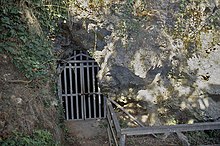Guattari cave
The Guattari Cave is a paleoanthropological and archaeological site in the municipality of San Felice Circeo on the coast of the province of Latina in Italy . The name of the cave refers to A. Guattari, the owner of the site on which the entrance to the cave was discovered during construction work in February 1939. Under the direction of the geologist and paleontologist Alberto Carlo Blanc (1906–1960), the cave was immediately explored and hominine fossils were retrieved for a scientific analysis by Sergio Sergi before his arrival in San Felice Circeo(1878–1972) secured. The fossil finds involved the completely preserved skull of a Neanderthal man (name at the time: Circeo 1 ) and a partially preserved Neanderthal lower jaw . In August 1950, Antonio Ascenzi and Giovanni Lacchei discovered a second lower jaw fragment in the outer area of the cave in a breccia dump . Furthermore were stone tools from the period of Moustérien discovered, which are attributed to the culture of Neanderthaloid. The cave has been explored again since 2019. In 2021, the remains of nine Neanderthals from very different eras were discovered.
research
The cave was explored until the early 1950s and only since 2019. At times, damage to the skull in the area of the foramen magnum was interpreted as an indication of a cannibalistic rite. In the 1980s, however, new investigations showed that the damage was probably caused by bites from Pleistocene spotted hyenas (so-called cave hyenas ).
Using uranium-thorium dating and ESR dating , an age of 51,000 years was determined for the location of the fossils recovered in 1939 and 1950 (archive numbers Guattari 1, 2, 3 , formerly Circeo I, II, III ).
In May 2021, the Italian Ministry of Culture reported that in a previously undeveloped area of the cave, researchers had discovered the remains of a total of nine Neanderthals in addition to numerous other animal and plant fossils: seven men, one woman and one male adolescent or child. What have been preserved are " skull caps , broken jawbones, two teeth, part of a thumbbone of the right hand and dozens of smaller splinters." According to the report, a preliminary dating revealed that these Neanderthals come from different eras; they are between 50,000 and 68,000 years old, and one of the dead may even be around 100,000 years old.
According to the findings, the bodies or body parts of the Neanderthals were probably dragged into the cave by hyenas. At a point in time that has not yet been precisely dated, the access to the newly developed cave area was buried - possibly due to an earthquake - so that today it is possible to examine the undisturbed condition of the cave floor for tens of thousands of years.
literature
- Alberto Carlo Blanc: L'uomo fossile del Monte Circeo. Un cranio neandertaliano in the Grotta Guattari a San Felice Circeo. In: Rivista di anthropologia. Volume 32, 1938-39, pp. 1-18.
- Sergio Sergi: Il cranio neandertaliano del Monte Circeo. In: Rivista di anthropologia. Volume 32, 1938-39, pp. 19-34.
- Sergio Sergi: La mandibola neandertaliana Circeo II. In: Rivista di Antropologia. Volume 41, 1954, pp. 305-344.
- Sergio Sergi and Antonio Ascenzi: La mandibola neandertaliana Circeo III (mandibola B). In: Rivista di Antropologia. Volume 42, 1955, pp. 337-403.
- Amilcare Bietti and Giorgio Manzi (Eds.): Proceedings of the International Symposium The Fossil Man of Monte Circeo. Fifty years of studies on the Neandertals in Latium. In: Quaternaria Nova. Volume 1, 1991, pp. 9-678.
- Marcello Piperno and Giovanni Scichilone (eds.): Il Cranio neandertaliano Circeo I. Studi e documenti. Istituto Poligrafico e Zecca dello Stato, Rome 1991, ISBN 978-8824001236 .
- Mary C. Stiner : The Faunal Remains From Grotta Guattari: A Taphonomic Perspective. In: Current Anthropology. Volume 32, No. 2, 1991, pp. 103-117, doi: 10.1086 / 203930 .
Web links
- Neanderthal, dalla Grotta Guattari al Circeo nuove incredibili scoperte. Ministero della cultura, press release of May 8, 2021 (Italian)
supporting documents
- ^ Entry Grotta Guattari in Bernard Wood (ed.): Wiley-Blackwell Encyclopedia of Human Evolution. 2 volumes. Wiley-Blackwell, Chichester et al. 2011, ISBN 978-1-4051-5510-6 .
- ↑ Valentina Giuffra et al .: Antonio Ascenzi (1915-2000), a Pathologist devoted to Anthropology and Paleopathology. In: Pathologica. Volume 102, 2010, pp. 1-5.
- ↑ Mariella Taschini: L'industrie de lithique Grotta Guattari au Mont Circé (Lazio): définition culturelle, et typologique chronologique you Pontinieni. In: Quaternaria Roma. Volume 21, 1979, pp. 179-247.
- ↑ Thesis Neanderthals Weren't Cannibals, So Who Ate Them? Stone Age Hyenas. On: nytimes.com from May 8, 2021.
- ^ Nicholas Toth and Tim White : Assessing the ritual cannibalism hypothesis at Grotta Guattari. In: Quaternaria Nova. Volume 1, 1990, pp. 213-222.
- ↑ Tim White and Nicholas Toth: The Question of Ritual Cannibalism at Grotta Guattari. In: Current Anthropology. Volume 32, No. 2, 1991, pp. 118-138, doi: 10.1086 / 203931 .
- ^ Proposal for a New Denomination of the Monte Circeo Fossil Hominids. In: Quarternaria Nova , Volume 1, 1990/91, pp. 47-48.
- ^ Henry P. Schwarcz et al .: On the reexamination of Grotta Guattari: uranium-series and election-spinresonance dates. In: Current Anthropology. Volume 32, No. 3, 1991, pp. 313-316, doi: 10.1086 / 203959 .
- ↑ Neanderthals were prey for these animals. On: sueddeutsche.de from May 10, 2021.
- ^ Nine Neanderthals from central Italy. On: Spektrum.de from May 10, 2021.
- ^ Remains of nine Neanderthals found in cave south of Rome. On: theguardian.com from May 8, 2021.
Coordinates: 41 ° 14 ′ 0 ″ N , 13 ° 5 ′ 0 ″ E

